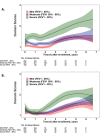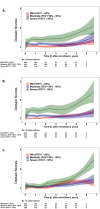Dynamic changes in quality of life in older patients with chronic obstructive pulmonary disease: a 7-year follow up
- PMID: 39256723
- PMCID: PMC11389236
- DOI: 10.1186/s12955-024-02296-1
Dynamic changes in quality of life in older patients with chronic obstructive pulmonary disease: a 7-year follow up
Abstract
Purposes: Chronic obstructive pulmonary disease (COPD) is a major cause of the rapid decline of health-related quality of life (HRQoL), associated with accelerated frailty in older populations. This study aimed to analyse the long-term dynamic changes of HRQoL and the predictive factors for the rapid decline of HRQoL in older patients with COPD.
Methods: Overall 244 patients with COPD, aged ≧ 65 years from one medical centre were enrolled between March 2012 and July 2020. Further, we prospectively assessed HRQoL scores with utility values, using EuroQol Five-Dimension (EQ-5D) questionnaires. Additionally, long-term dynamic changes in HRQoL were analysed using the Kernel smoothing method and examined the factors contributing to the deterioration of HRQoL using a linear mixed effects model.
Results: Older patients with COPD with forced expiration volume (FEV1) < 50% of prediction entered the phase of rapid and continuous decline of HRQoL ~ 2 years after enrolment, but patients with FEV1 ≥ 50% of prediction without rapidly declined HRQoL during 7 years follow up. Therefore, FEV1 < 50% of prediction is a novel predictor for the rapid decline of HRQoL. The course of rapidly declining HRQoL occurred, initially in the usual activities and pain/discomfort domains, followed by the morbidity, self-care, and depression/anxiety domains ~ 2 and 4 years after enrolment, respectively. The mixed effects model indicated that both FEV1 < 50% of prediction and a history of severe acute exacerbation (SAE) requiring hospitalisation were contributing factors for deterioration in HRQoL .
Conclusions: Both FEV1 < 50% of prediction and exacerbations requiring hospitalisation were contributing factors for the deterioration of HRQoL in long-term follow up. Additionally, FEV1 < 50% of prediction was a novel predictor for patients entering the phase of rapid decline of HRQoL.
Keywords: Chronic obstructive pulmonary disease; Dynamic change.; Quality of life.
© 2024. The Author(s).
Conflict of interest statement
The authors declare no competing interests.
Figures



References
-
- Mannino DM, Buist AS. Global burden of COPD: risk factors, prevalence, and future trends. Lancet. 2007;370(9589):765–73. - PubMed
-
- Waatevik M, Skorge TD, Omenaas E, Bakke PS, Gulsvik A, Johannessen A. Increased prevalence of chronic obstructive pulmonary disease in a general population. Respir Med. 2013;107(7):1037–45. - PubMed
-
- Netuveli G, Blane D. Quality of life in older ages. Br Med Bull. 2008;85:113–26. - PubMed
-
- Engström CP, Persson LO, Larsson S, Sullivan M. Health-related quality of life in COPD: why both disease-specific and generic measures should be used. Eur Respir J. 2001;18(1):69–76. - PubMed
-
- Peruzza S, Sergi G, Vianello A, et al. Chronic obstructive pulmonary disease (COPD) in elderly subjects: impact on functional status and quality of life. Respir Med. 2003;97(6):612–7. - PubMed
MeSH terms
Grants and funding
- NSTC 112-2314-B-006-101-MY2/National Science and Technology Council
- NSTC 112-2314-B-006-101-MY2/National Science and Technology Council
- NSTC 112-2314-B-006-101-MY2/National Science and Technology Council
- NSTC 112-2314-B-006-101-MY2/National Science and Technology Council
- NSTC 112-2314-B-006-101-MY2/National Science and Technology Council
- NCKUH-11303007/National Cheng Kung University Hospital
- NCKUH-11303007/National Cheng Kung University Hospital
- MOST107-2627-M-006-007, MOST 109-2314-B-006-091, and MOST 110-2314-B-006-099/Ministry of Science and Technology
- MOST107-2627-M-006-007, MOST 109-2314-B-006-091, and MOST 110-2314-B-006-099/Ministry of Science and Technology
- MOST107-2627-M-006-007, MOST 109-2314-B-006-091, and MOST 110-2314-B-006-099/Ministry of Science and Technology
- MOST107-2627-M-006-007, MOST 109-2314-B-006-091, and MOST 110-2314-B-006-099/Ministry of Science and Technology
- MOST107-2627-M-006-007, MOST 109-2314-B-006-091, and MOST 110-2314-B-006-099/Ministry of Science and Technology
- NHRI-107A1-EMCO-02181810/National Health Research Institutes
LinkOut - more resources
Full Text Sources
Medical

